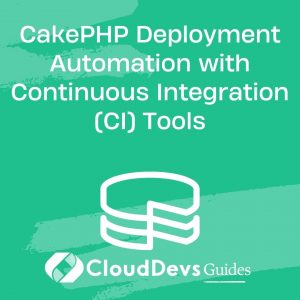CakePHP Deployment Automation with Continuous Integration (CI) Tools
In today’s fast-paced software development landscape, the ability to deliver new features and updates swiftly and reliably is paramount. One of the critical aspects of achieving this goal is deploying applications efficiently and without errors. For CakePHP applications, deploying updates can be a complex process involving numerous steps. This is where Continuous Integration (CI) tools come to the rescue. CI tools automate the deployment process, ensuring that code changes are thoroughly tested and seamlessly pushed to production. In this guide, we will explore how to streamline the deployment of CakePHP applications using CI tools, ensuring a smoother development workflow and enhanced application reliability.
Table of Contents
1. Why CakePHP Developers Need Deployment Automation
CakePHP, a popular PHP framework, empowers developers to build robust and feature-rich applications with ease. However, the process of deploying these applications can be intricate, involving tasks such as code compilation, database migration, asset management, and more. Manual deployments are error-prone, time-consuming, and can lead to inconsistencies across environments. Deployment automation addresses these challenges by automating the deployment pipeline, leading to consistent and predictable releases.
2. Continuous Integration (CI) and Its Benefits
Continuous Integration (CI) is a development practice that involves automatically integrating code changes from multiple contributors into a shared repository. This approach, coupled with automated testing and deployment, ensures that changes are thoroughly validated before reaching production. The benefits of CI include:
- Faster Feedback: CI tools provide rapid feedback on code changes, allowing developers to catch and rectify issues early in the development process.
- Reduced Manual Errors: Automation eliminates the risk of human errors that often occur during manual deployments.
- Consistency: CI tools ensure that the deployment process remains consistent across different environments, reducing the likelihood of configuration-related issues.
- Efficiency: By automating testing and deployment, developers can focus on coding rather than spending time on manual deployment tasks.
3. Setting Up CakePHP Deployment Automation with CI Tools
Here, we’ll walk through the process of setting up CakePHP deployment automation using popular CI tools. For this example, we’ll use Jenkins as the CI tool of choice.
Note: The following steps are based on the assumption that you have a CakePHP project already under version control using a platform like Git.
Step 1: Configure Your CakePHP Application
Ensure that your CakePHP application is properly configured for deployment. This includes setting environment-specific configurations, configuring the database connection, and managing assets. Make sure that your application is ready to be deployed to different environments seamlessly.
Step 2: Set Up Jenkins
- Install Jenkins: Follow the installation instructions for your operating system from the official Jenkins website.
- Install Required Plugins: Jenkins offers a wide range of plugins to extend its functionality. Install plugins such as Git, CakePHP, and any others you might need for your project.
Step 3: Create a Jenkins Job
- Create a New Job: In Jenkins, create a new job for your CakePHP project by selecting “New Item” and choosing the appropriate job type (e.g., Freestyle project).
- Configure Source Code Management: Under the job configuration, specify your Git repository URL and the branch you want to deploy.
- Set Up Build Triggers: Configure build triggers to automatically start a build whenever changes are pushed to the repository.
- Configure Build Steps: Define the build steps required for deployment. This might include running unit tests, running database migrations, compiling assets, etc.
- Post-Build Actions: Define actions to be taken after the build is successful. This could involve archiving build artifacts, sending notifications, or triggering deployment to specific environments.
Step 4: Deployment Automation
Using CakePHP deployment scripts or tools, automate the process of deploying your application to different environments. This might involve copying files, updating configurations, and executing post-deployment tasks.
Step 5: Testing
Integrate automated testing into your Jenkins job to ensure that your CakePHP application functions as expected after deployment. This can include unit tests, integration tests, and any other relevant tests.
Step 6: Monitoring and Rollbacks
Implement monitoring tools to track the health of your deployed application. Additionally, set up a process for rolling back deployments in case of any unexpected issues.
Conclusion
Automating the deployment of CakePHP applications using Continuous Integration tools is a game-changer for development teams. It eliminates the hassles of manual deployment, reduces errors, and accelerates the release cycle. By following the steps outlined in this guide, you can establish a streamlined deployment pipeline for your CakePHP projects. Embrace the power of CI tools and enjoy efficient, reliable, and error-free deployments that contribute to the success of your applications.
Table of Contents








